Affinity Designer vs. Illustrator: Features
Affinity Designer
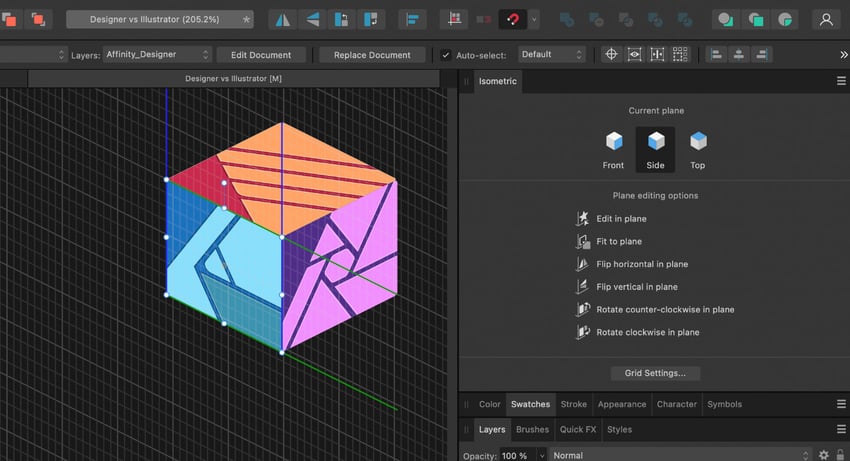
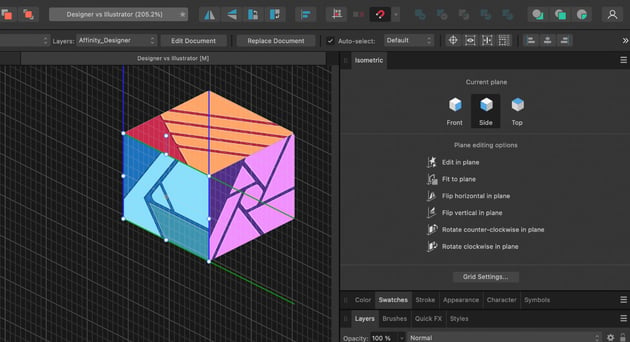
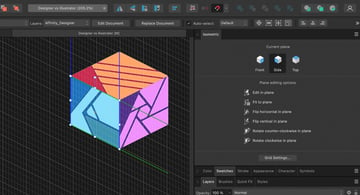
Affinity Designer boasts a powerful and unique feature set. While it has sought to incorporate many of the most popular features from Illustrator, it has also differentiated itself by taking a fundamentally different approach to the workflow. Crucially, it supports both raster and vector workflows natively. Some of its standout features include:
- Personas: This allows seamless switching between vector and raster modes within the same application. While this doesn’t attempt to offer feature parity with Photoshop, it does make sketching, drawing, and adding a handmade aesthetic to your art much less cumbersome.
- Powerful Grid System: Affinity Designer’s grid system is truly second to none. It offers powerful granular control of grid layout and subdivisions. It also provides isometric grids and even a panel that assists with isometric drawing for a unique 3D isometric look.
- Live Effects: You can apply and see the effects in real time, making the design process more intuitive.
- Drag-and-Drop Clipping and Masking: Creating in Affinity Designer is significantly streamlined by its clipping and masking system, which allows for easy and intuitive management of clipping content in the same way that you manage groups in the layer stack.
- Live Booleans: In addition to the destructive Boolean operations (add shapes, subtract shapes, either or, etc.), Affinity Designer provides live boolean operations that preserve the original shapes and can be edited non-destructively.
- Fully Featured iPad App: It is particularly useful to be able to draw interactively on the iPad and have full access to all of the features you need, without having to send work to a desktop or laptop.
- Intuitive Drawing Tools: In both the desktop and iPad versions, Designer provides a large number of brushes out of the box, with support for pen pressure input and combinations of vector and raster brushes.
- Seamless Integration With the Affinity Suite: As long as Designer is installed, you can access it from within Affinity Publisher directly, and it even opens many Affinity and Adobe file types.
Adobe Illustrator


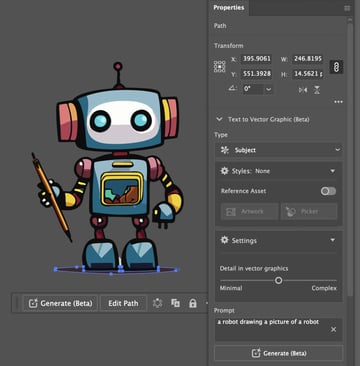
Adobe Illustrator is the industry standard for vector graphic design, and its age has given Adobe time to build out a massive toolset. It also offers integration with other Adobe applications and Adobe Creative Cloud. Some of its most powerful features include:
- Advanced Vector Tools: Tools like blend, image trace, and pattern builder are just a few of the incredibly powerful design tools that simply have no equal. These allow designers to work smarter and create mind-blowing art with relatively simple setups.
- Adobe Ecosystem Features: In addition to the integration between Illustrator and other Adobe applications, Illustrator also provides direct access to Adobe Creative Cloud tools.
- Libraries allow you to save assets and reuse them in other Adobe apps seamlessly. They also allow you to use the Adobe Capture app on your phone to scan color schemes, vector shapes, fonts, 3D materials, and patterns from the world around you.
- Adobe Fonts makes it easy to find the font you need, use it in multiple projects in different apps, and collaborate with others without having to worry about missing fonts.
- File syncing keeps your work backed up, makes it available on multiple devices, and allows you to share it with others easily.
- Illustrator on the iPad: The iPad version of Illustrator offers a smooth and intuitive drawing experience and can send files seamlessly to the desktop app through Creative Cloud.
- 3D Design Tools: Recently, Adobe has added some basic 3D features to Illustrator so that you can turn 2D vector shapes into 3D shapes and add materials and lighting to them quickly, without having to go into a separate application for very basic shapes.
- AI Generation: Adobe Firefly can generate vector art based on text input right within Illustrator and speed up concept development.
Verdict: Adobe Illustrator
Adobe Illustrator takes the cake when it comes to the sheer number of tools it offers. Many of those tools may be necessary for designers who have come to rely on them, and many have worked their way into prominence within the Illustrator UI, but others can feel gimmicky and tacked on.
Affinity Designer’s feature set is more limited, but it is also more focused. In terms of Adobe Illustrator vs. Affinity Designer’s features, Adobe easily wins in terms of sheer volume. Designer may be a better choice for those who want to draw by hand and achieve a more natural look or those who simply dislike working in Illustrator.
Affinity Designer vs. Illustrator: Performance



Performance heavily influences the way a designer works with an app. For those who want to draw interactively, smooth performance is essential. The comparison of Affinity Designer vs. Adobe Illustrator in terms of performance is heavily influenced by the age of the respective apps and by their feature sets.
Affinity Designer
Affinity Designer is renowned for its speed, efficiency, and reliability. It performs exceptionally well on both ARM and Intel silicon. Even less powerful desktops and iPads can run the app with ease. This is particularly beneficial for complex projects with multiple layers and effects. Affinity Designer also handles both vector and raster formats with ease.
Adobe Illustrator
Adobe Illustrator’s three decades in the market are a boon for its feature set but a liability in terms of performance. All of the extra features consume system resources, and on top of that, the Illustrator code base is simply more dated.
While Adobe has diligently worked to improve performance, it does still feel clunky to work with. Many features still don’t provide live updates in the UI and require a lot of undoing and redoing. Adobe Illustrator can be especially resource-intensive when working with raster images. Even users with powerful, high-end machines will experience slowdowns and loading bars.
Verdict: Affinity Designer
When it comes to Affinity Designer vs. Illustrator in terms of raw performance, Affinity Designer is the clear winner. It runs more smoothly on everything from powerful desktops to iPads. Illustrator’s larger feature set comes at the expense of a smooth and interactive experience. Ultimately, performance further reinforces Affinity Designer’s position as the choice for designers who want to draw and paint interactively.
Affinity Designer vs. Illustrator: User Interface
The user interface is more than simply being able to find the tool or object you want. It influences how quickly you can work with the application, even more than raw performance. Looking at Adobe Illustrator vs. Affinity Designer in terms of the interface is a complex question because both applications have very similar interfaces. The difference largely comes down to how they showcase their feature sets.
Affinity Designer


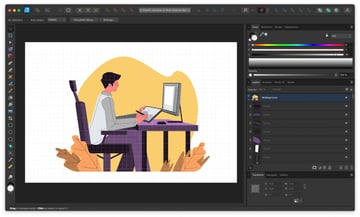
Just like Adobe Illustrator, Affinity Designer provides panels for everything from layers to color, swatches, strokes, effects, appearance, and more. It’s highly customizable like Illustrator, and there’s also a context-sensitive bar at the top of the window and a toolbar on the left. Adobe Illustrator professionals will have little trouble navigating the majority of the Affinity Designer interface. There are some key differences, however:
- Emphasis on a smooth and interactive experience: My favorite example of this is the way Designer handles clipping and masking. It does not require opening any menus—simply drag a shape onto the layer you want to clip it to. Similarly, drag a mask onto the thumbnail image of the layer you want to mask. There’s no masking panel and no clipping operation like Illustrator—it’s all handled the same way you would manage groups in the layer stack. Live boolean operations are handled similarly. Furthermore, natural interaction is heavily emphasized in Designer, so pen pressure and stabilizer controls are front and center on the context menu.
- Reduced Menu Size: Affinity Designer tends not to double up on functionality in the interface, creating a more streamlined experience but also making it a bit more confusing to remember where operations are. For example, the boolean operations to combine shapes are always available on the command bar at the top, but the non-destructive “compound shapes” function is only available on the Layer menu. Nothing indicates that the destructive operations on the command bar do not provide a path to non-destructive compound shapes.
- Colorful Icons: Affinity Designer’s icons are very easy to navigate given that they are color-coded by function set. Of course, there is an option to change to a monochromatic interface in the settings menu for those who find the colorful icons distracting, but it can make finding things much easier once you get used to the color coding.
Adobe Illustrator
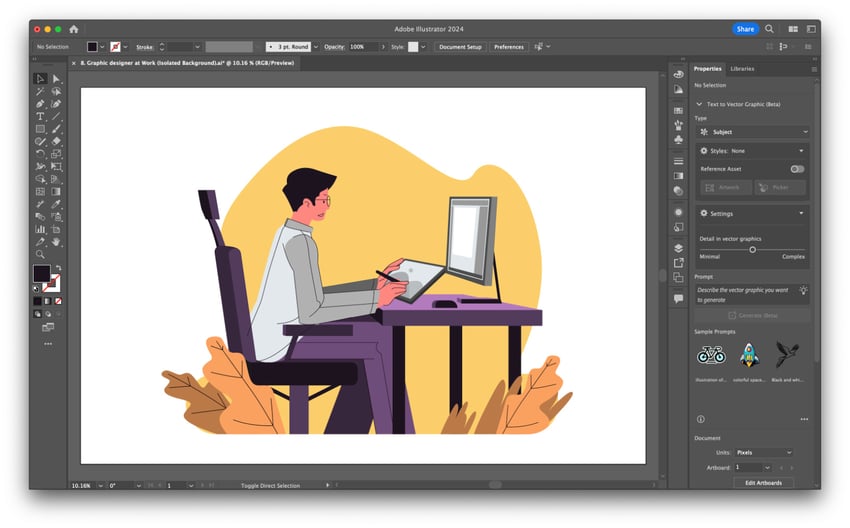
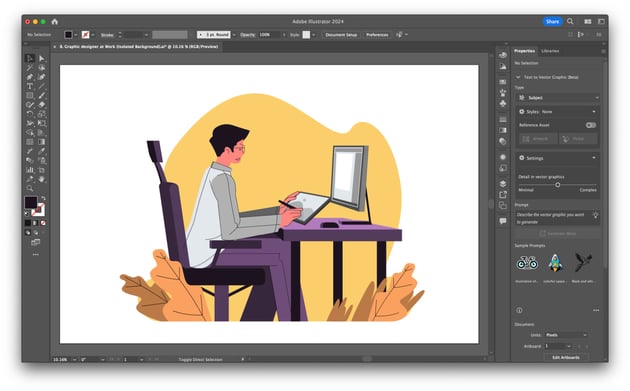
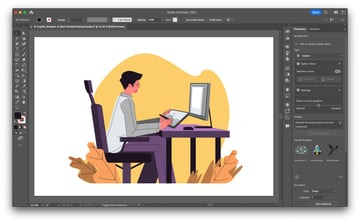
Adobe Illustrator’s large number of functions means a more complex interface. That can be somewhat daunting for beginners, so Adobe likes to put its most popular tools at the forefront of the application. The primary difference between Adobe Illustrator vs. Affinity Designer’s interface comes down to the accessibility of functions.
- Multiple ways to engage a tool: Putting tools at the forefront means that there are often multiple ways to access a given tool. The Shape Builder Tool, for example, is a more intuitive and dynamic way to work with boolean operations. Similar functionality can also be found under Object > Compound Path > Make and on the Pathfinder panel under the Window menu. The Blend Yool is another popular function from the Object menu that received its own tool in the toolbar.
- The properties panel: Adobe has largely moved away from the context bar at the top in favor of a context-sensitive panel called the Properties panel, which seeks to put all of the functions you might want in a single place, which works some of the time.
- The taskbar: In addition to the Properties panel, Illustrator also provides the taskbar, which floats in the work area just below whatever you have selected. You can pin the taskbar and hide it if you find it’s getting in the way, but the idea is to put frequently used functions right where you need them.
Verdict: Affinity Designer
Comparing Affinity Designer vs. Illustrator’s interface can be highly subjective, but when it comes to working with the applications, I find Affinity’s more concise approach much faster and more pleasant.
Adobe’s commitment to putting tools in front of you does not streamline the workflow the same way smoother performance and emphasis on interactivity do in Affinity Designer. It’s more of a distraction. Except for tools like Shape Builder, a lot of the elements Adobe has added to the Illustrator interface have simply become bloat. Adobe doesn’t know a given designer’s workflow, and a lot of the interface elements that attempt to help, like the taskbar floating in the work area and the Properties panel replacing my default stack of panels, simply get in the way.
All of the extra functionality Illustrator offers will of course necessitate a more complex interface, but Adobe doesn’t do itself any favors by duplicating functionality and putting slightly different functions like Shape Builder, Compound Paths, and Pathfinder in multiple places. Fortunately, you can customize the interface to your workflow, but at the same time, Affinity Designer doesn’t require a custom interface to feel quick and useful.
Affinity Designer vs. Illustrator: Pricing



We won’t get into the exact prices of the applications in this article since Adobe regularly updates them and both companies offer discounts and bundle deals. It is a significant consideration, however, so we will discuss the pricing model as they differ substantially.
Affinity Designer
One of the biggest advantages of Affinity Designer is its pricing model. It offers the apps on a one-time payment price for each of the apps in the suite, including Designer, Photo, and Publisher (equivalent to Illustrator, Photoshop, and InDesign in the Adobe suite.) The apps can be purchased separately, and in that case, at the time of writing, Windows, macOS, and iPadOS apps are all sold separately. Affinity does offer a bundle that includes all of the apps on all supported operating systems as well. When the version 2 apps were released, they did require a second purchase, but even so, the pricing model still puts it at a very affordable price point, making it a cost-effective option for individual users and small businesses.
Adobe Illustrator
Adobe Illustrator is part of the Adobe Creative Cloud suite, which operates on a subscription-only model. While this means ongoing costs, it also provides access to regular updates and other Adobe apps, cloud services, fonts, and more. The cost can add up quickly for freelancers or small businesses on a budget. At the time of writing, there are options to subscribe to just Illustrator or smaller bundles of apps, and there are some education discounts available. The various bundles, discounts, and Creative Cloud offerings do change regularly, so be sure to research the pricing in detail and read all the fine print before choosing a bundle.
Verdict: Affinity Designer
There is a reason that Adobe’s decision to move to a subscription-only model in 2013 was vociferously decried by designers: it’s expensive. To be fair, Adobe CS6 was expensive when it was a one-time purchase too, but it was also an investment that provided years of value.
In addition to the cost, the subscription model makes it hard to access the work you’ve created if you quit paying for the subscription—all of the AI and PSD and INDD files you have will become inaccessible. The one-time payment for Affinity Designer makes it the clear winner in terms of cost.
Affinity Designer vs. Illustrator: Ecosystem and Support
The ecosystem of Adobe Illustrator vs. Affinity Designer is tough to compare. The two apps and their associated suites take very different approaches to interoperability, and we can’t talk about Designer and Illustrator in isolation without discussing their respective suites.
Affinity Designer

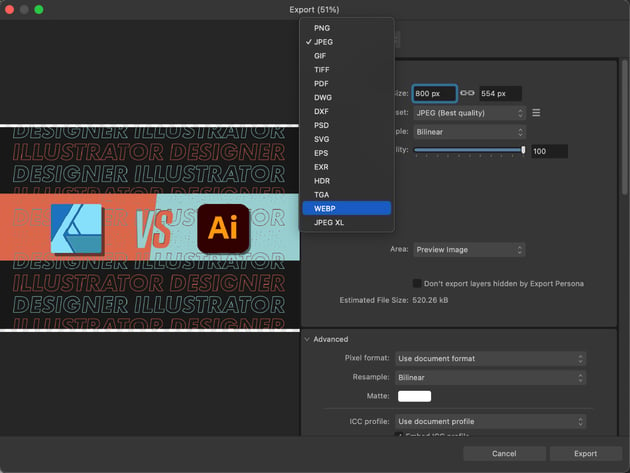
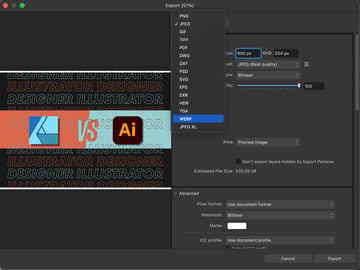
Affinity Designer is part of the Affinity suite, which includes Affinity Photo and Affinity Publisher. The three apps are very tightly integrated. Affinity Publisher provides a unique feature in the form of Designer and Photo personas in which you can access the full Affinity Designer and Affinity Photo applications directly from within the Publisher interface.
The Affinity suite doesn’t enjoy broad industry support, but they have gone to considerable lengths to support as many industry formats as possible. That includes both the formats that they will export to and the formats they will read. Affinity Designer can open a broad range of documents, including raster and vector formats and even Adobe formats like AI, PSD, and PDF. It can also export to a wide variety of formats including JPG, PNG, PSD, PDF, EXR, and even newer formats like WebP and JXL. Even if Affinity Designer AFDESIGN files don’t enjoy the same broad support that PSD and AI files do, you can generally export to something that third-party applications do support.
In terms of platform support, Affinity Designer is available on Windows, macOS, and iPadOS.
Adobe Illustrator
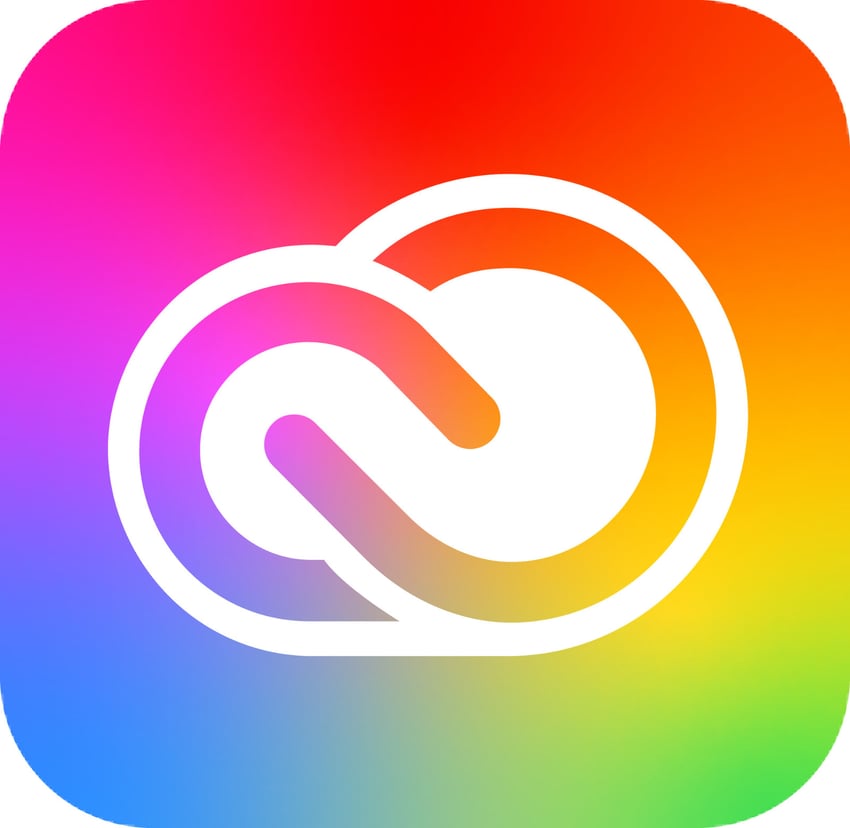
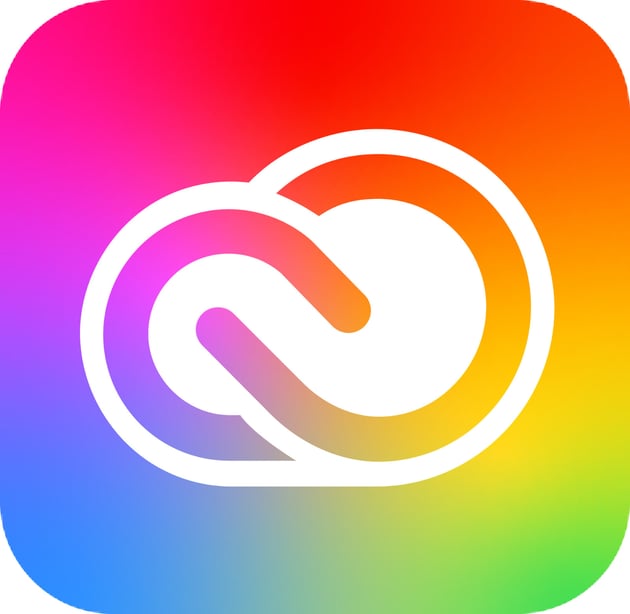
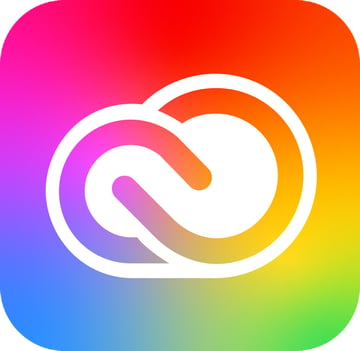
Adobe Illustrator benefits from being part of Adobe Creative Cloud, which includes an array of professional-grade tools and useful asset management tools like Creative Cloud Libraries. The integration across Adobe apps is far from seamless, but you can do things like importing AI files directly into After Effects projects and even copying vector shapes in Illustrator and pasting them into After Effects.
There is also broad third-party support for Illustrator files. For example, you can import AI files into 3D apps and use the 2D vector shapes to build 3D forms. Manufacturing tools like laser cutters, CNC machines, and sewing machines also use AI files in production. Adobe also offers a large community for support.
Adobe Illustrator runs natively on Windows and macOS. Its iPadOS offerings, like most of the Creative Cloud apps, are stripped down and optimized for a touch interface.
Verdict: Adobe Illustrator
The Adobe ecosystem is simply massive, and its apps are the industry standard in nearly every creative industry. The interoperability between Illustrator and other Adobe apps leaves something to be desired when compared with the tight integration of the Affinity suite apps, but the third-party support for Adobe Illustrator files makes it indispensable in certain industries.
The Verdict on Adobe Illustrator vs. Affinity Designer
Being the “industry standard” has always been a double-edged sword. It’s a little like being the Microsoft Word of vector design. Adobe Illustrator can do pretty much anything you need it to, no matter what industry you’re in, but working with it won’t necessarily be efficient or pleasant. When it comes to Adobe Illustrator vs. Affinity Designer, “best” depends heavily on a given designer’s workflow and needs.
- Affinity Designer is best for:
- freelancers and small businesses on a tight budget
- artists who want to work with a pen tablet or iPad and draw directly in the interface
- designers working extensively with print layout who will benefit from Affinity Publisher’s benefits over InDesign
- UI, UX, and front-end developers working in Figma, Webflow, Framer, or code who primarily need SVG assets
- Adobe Illustrator is best for:
- large collaborative in-house graphic design teams that will be using the Creative Cloud asset management
- motion designers and animators who work extensively with Adobe After Effects, Premiere Pro, and/or Animate
- technical and production professionals who will be creating physical materials with laser cutters or CNC machines
- designers who will benefit from AI generation tools
Both programs are powerful and capable, and either will serve you well in creating stunning vector graphics. Choosing one over the other will depend entirely on your industry and workflow.
That said, there’s nothing precluding you from using both. Even if you need Illustrator for specific features like integration with After Effects, you can still use Affinity Designer when you want a more streamlined interface and more usable pen pressure and drawing tools.